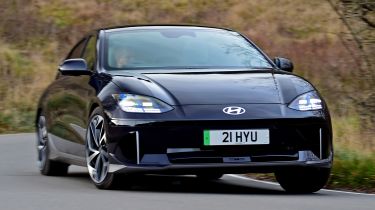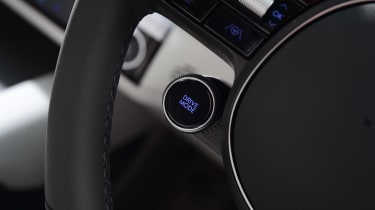Hyundai Ioniq 6 review: performance, motor & drive
The Ioniq 6 is by no means a true driver’s car, but it’s slightly more fun to drive than its Ioniq 5 sibling
| Model | 0-62mph | Top speed | Driven wheels | Power |
|---|---|---|---|---|
| Single motor | 7.4s | 115mph | Rear | 225bhp |
| Dual-motor | 51.s | 115mph | Four | 316bhp |
We praised the Hyundai Ioniq 5 for its cushy and comfortable ride, but while there’s a hot ‘N’ model on the way, the standard car offers little in terms of driver engagement. For the Ioniq 6, the boffins at Hyundai have tweaked with the car’s setup to make it feel a little more dialled-in and sharper to drive on a twisty road. A BMW i4 is even more engaging, and a Tesla Model 3 is faster in a straight line, but the Ioniq 6 is impressive nonetheless and should be more than satisfying for most buyers.
Hyundai Ioniq 6 0-62mph, top speed and acceleration
The 225bhp on tap in single motor models doesn’t deliver the same eye-widening acceleration as a Tesla, but the instant torque delivery makes the Ioniq 6 feel pretty swift. The 316bhp dual-motor model’s 5.1-second 0-62mph time felt a tad conservative to us, too; acceleration was effortless thanks to the enormous amount of torque on tap. Progress isn’t quite as urgent once you’re at motorway speeds, but there's still plenty of poke for overtaking.
Even the calibration of the brake pedal feels as though it's been tweaked compared with the Ioniq 5. The transition between energy recuperation and the physical brakes, which is something other brands have yet to perfect, is nicely judged in the Ioniq 6. You get five levels for the regenerative braking, including the i-Pedal one-pedal driving mode.
Handling
While its ducktail spoiler and low-profile tyres may try to convince you otherwise, the Ioniq 6 is designed to be more of a composed cruiser than a sports saloon. The ride feels firm but well-damped, offering a decent balance of comfort and body control compared to the unashamedly soft Ioniq 5
That’s not to say there’s no fun to be had; the Hyundai’s low stance makes it feel composed and ensures there’s very little body lean when you throw it into a corner. We wish more weight was added to the steering in Sport mode, though, as this can feel a little overassisted and somewhat disconnected from the front axle. Having said that, it’s easy to feel when the Ioniq 6 begins to understeer, which is a little sooner than we’d like – no doubt a result of the car’s hefty kerb weight.
On a more positive note, the Ioniq 6’s long wheelbase (the distance between the front and rear wheels) makes the car feel especially stable when cruising. Its slippery shape also ensures there’s very little wind noise at motorway speeds, too. A BMW i4 might remain the choice for the keenest drivers, but the Ioniq 6 is a tempting proposition for those who can’t stand the crashier ride of the Polestar 2.





